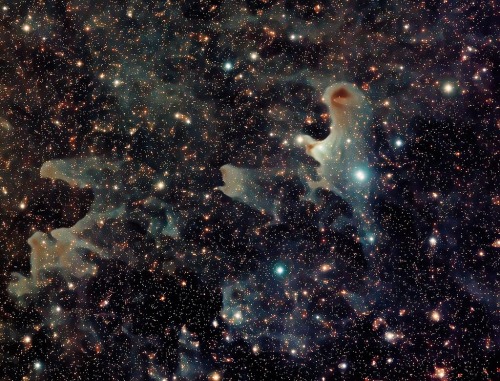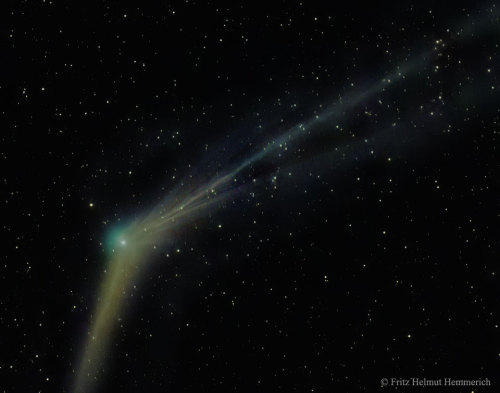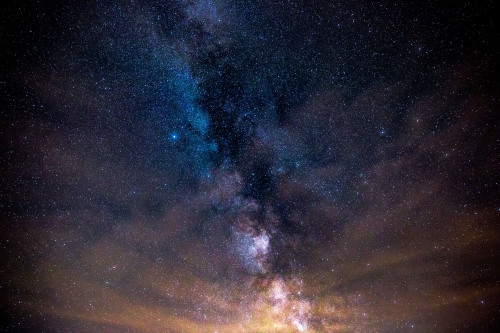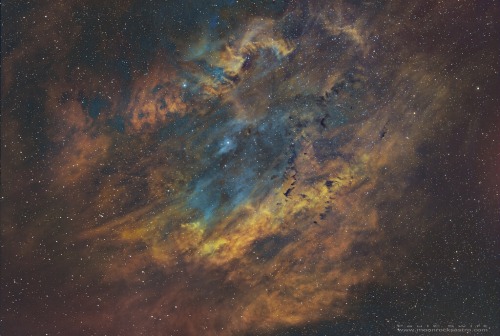Herschel’s Eagle Nebula, Some 6,500 Light-years Away.

Herschel’s Eagle Nebula, some 6,500 light-years away.
Image Credit & Copyright: ESA/Herschel/PACS, SPIRE/Hi-GAL Project
More Posts from Littlecadet-biguniverse and Others

The Milky Way was so very alive this weekend in the backcountry.. Hope you all had a chance to look up and watch the cosmos whiz by.. #stars #nightphotography #nightsky #darksky #adventure

Charon and Pluto: Strikingly Different Worlds
js

VdB 141 Region Nebulosity by Jeffrey Weiss on Flickr.

Comet Catalina Emerges : Comet Catalina is ready for its close-up. The giant snowball from the outer Solar System, known formally as C/2013 US10 tails, making it an impressive object for binoculars and long-exposure cameras. The featured image was taken last week from the Canary Islands, off the northwest coast of Africa. Sky enthusiasts around the world will surely be tracking the comet over the next few months to see how it evolves. via NASA
js

Saturn in three bands of infrared light.

M8 // Lagoon Nebula (left of center) & M20 // The Trifid (bottom)

Solar filaments a.k.a. prominences – when observed at the solar limb (above), are long clouds of partially ionized plasma suspended above the Sun’s surface by strongly sheared magnetic structures, called filament channels, that can support the dense plasma against solar gravity. Filaments may form at various locations on the Sun, however, they are always found within preexisting filament channels above polarity inversion lines which separate areas of opposite magnetic polarity regions.
Credit: NASA/SDO/LMSAL

Milky Way js

Sh2-119 Sharpless 119,emission nebular in Narrowband by Paul C. Swift on Flickr.

Milky Way over Shelbyville, Indiana
js
-
 becxwilliams reblogged this · 8 years ago
becxwilliams reblogged this · 8 years ago -
 bayonet75 liked this · 8 years ago
bayonet75 liked this · 8 years ago -
 n1ghtwo1f reblogged this · 8 years ago
n1ghtwo1f reblogged this · 8 years ago -
 n1ghtwo1f liked this · 8 years ago
n1ghtwo1f liked this · 8 years ago -
 jaimeroman liked this · 8 years ago
jaimeroman liked this · 8 years ago -
 cukierbender-blog liked this · 8 years ago
cukierbender-blog liked this · 8 years ago -
 halfthot-t-tle reblogged this · 8 years ago
halfthot-t-tle reblogged this · 8 years ago -
 inspiredlunacy404 reblogged this · 8 years ago
inspiredlunacy404 reblogged this · 8 years ago -
 wanismailyusoff-blog liked this · 8 years ago
wanismailyusoff-blog liked this · 8 years ago -
 palkias-space reblogged this · 8 years ago
palkias-space reblogged this · 8 years ago -
 nagaguard reblogged this · 8 years ago
nagaguard reblogged this · 8 years ago -
 nagaguard liked this · 8 years ago
nagaguard liked this · 8 years ago -
 blue-sialia liked this · 8 years ago
blue-sialia liked this · 8 years ago -
 wickedequation reblogged this · 8 years ago
wickedequation reblogged this · 8 years ago -
 loserwithaplan-blog liked this · 8 years ago
loserwithaplan-blog liked this · 8 years ago -
 astlin reblogged this · 8 years ago
astlin reblogged this · 8 years ago -
 astlin liked this · 8 years ago
astlin liked this · 8 years ago -
 tea4thought reblogged this · 8 years ago
tea4thought reblogged this · 8 years ago -
 brettejensen45 liked this · 8 years ago
brettejensen45 liked this · 8 years ago -
 estefanotorrente-blog liked this · 8 years ago
estefanotorrente-blog liked this · 8 years ago -
 spacewinter reblogged this · 8 years ago
spacewinter reblogged this · 8 years ago -
 importantkryptonitemagazine liked this · 8 years ago
importantkryptonitemagazine liked this · 8 years ago -
 nithing-queen-blog liked this · 8 years ago
nithing-queen-blog liked this · 8 years ago -
 tiranosauriosrex liked this · 8 years ago
tiranosauriosrex liked this · 8 years ago -
 gabbie-giggles reblogged this · 8 years ago
gabbie-giggles reblogged this · 8 years ago -
 sgl14167-blog liked this · 8 years ago
sgl14167-blog liked this · 8 years ago -
 loathesome-is-love-blog reblogged this · 8 years ago
loathesome-is-love-blog reblogged this · 8 years ago -
 loathesome-is-love-blog liked this · 8 years ago
loathesome-is-love-blog liked this · 8 years ago -
 monkeychops84 liked this · 8 years ago
monkeychops84 liked this · 8 years ago -
 vicious-seamonkey reblogged this · 8 years ago
vicious-seamonkey reblogged this · 8 years ago -
 nelaaatkophotography-blog liked this · 8 years ago
nelaaatkophotography-blog liked this · 8 years ago -
 treacherousgods reblogged this · 8 years ago
treacherousgods reblogged this · 8 years ago -
 treacherousgods liked this · 8 years ago
treacherousgods liked this · 8 years ago -
 vicious-seamonkey liked this · 8 years ago
vicious-seamonkey liked this · 8 years ago -
 scrb1927-blog liked this · 8 years ago
scrb1927-blog liked this · 8 years ago -
 lietoome reblogged this · 8 years ago
lietoome reblogged this · 8 years ago -
 littlecadet-biguniverse reblogged this · 8 years ago
littlecadet-biguniverse reblogged this · 8 years ago -
 ostentatiousrrex liked this · 8 years ago
ostentatiousrrex liked this · 8 years ago -
 artslip liked this · 8 years ago
artslip liked this · 8 years ago -
 heatherfeather70 liked this · 8 years ago
heatherfeather70 liked this · 8 years ago
GREETINGS FROM EARTH! Welcome to my space blog! Let's explore the stars together!!!
144 posts